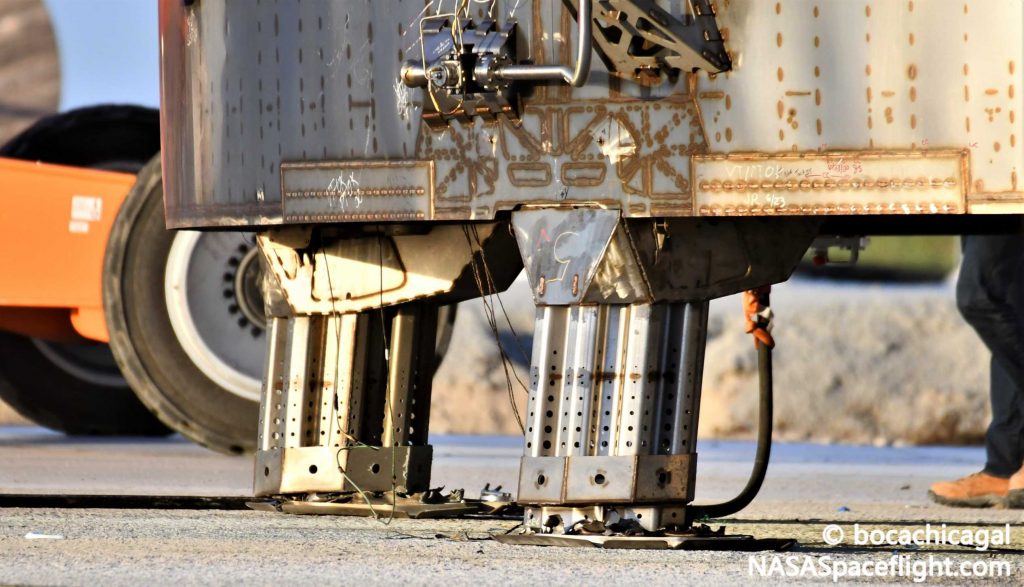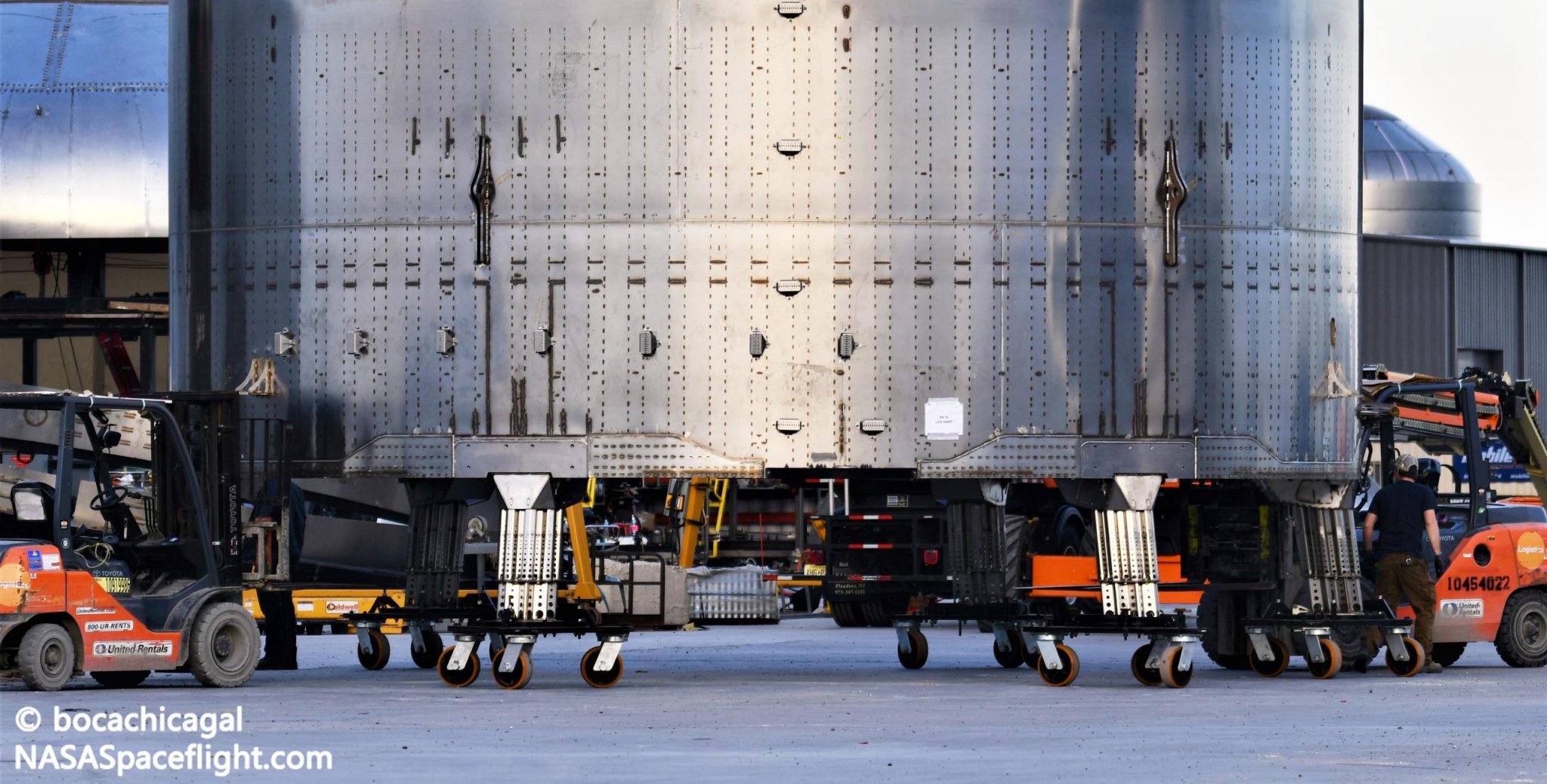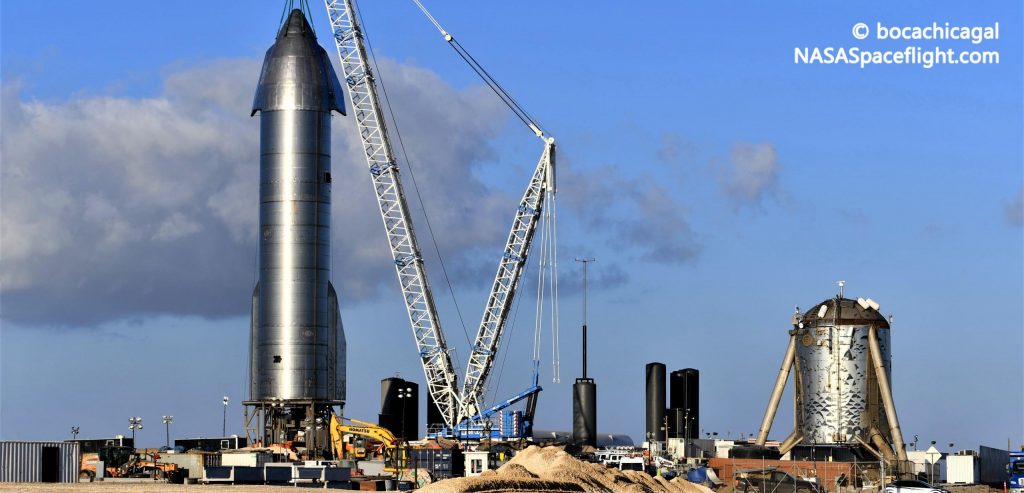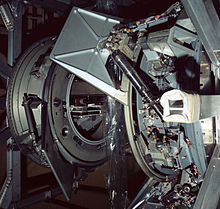New Mars Forums
You are not logged in.
- Topics: Active | Unanswered
Announcement
#26 2021-03-10 19:55:35
- SpaceNut
- Administrator
- From: New Hampshire
- Registered: 2004-07-22
- Posts: 29,917
Re: Six-legged freaks - can the Starship land on those legs?
Looking more closely at SpaceX landing legs. They appear to be nothing but metal posts. No shock absorber. Something as big as a Starship coming down that fast? Onto concrete? Even a relatively gentle landing will produce a great deal of shock. Any wonder why SN11 exploded?
GW Johnson is an engineer. Perhaps he could comment on this. All large airline aircraft have rubber tires and shock absorbers built into the legs. Landing without any form of shock absorber will produce a kaboom. An Earth shattering kaboom.
That would help the shock wave whether its done with pneumatics, springs. or by other methods not to mention the size of the pad that makes contact if larger does spread the wave out....
It also means that the end of the pole must be reinforced to be able to take the landing as well so that the metal does not tare as the wave follows the landing pole/pad leg upward....
Offline
Like button can go here
#27 2021-03-11 20:52:55
- SpaceNut
- Administrator
- From: New Hampshire
- Registered: 2004-07-22
- Posts: 29,917
Re: Six-legged freaks - can the Starship land on those legs?
Speaking of landing legs ... here is a bit of an update about the failure of SN10 ...
https://www.msn.com/en-us/news/technolo … ip-sn10-de
tonated-after-landing/ar-BB1esRWN?ocid=msedgdhpAccording to Musk, some issues that were already being worked out for the next prototype likely contributed to SN10’s landing issues. To be clear, the spacecraft did “land,” but it did so without a bit too rough for its landing legs to handle. The prototype apparently crushed its own legs when it landed, and Musk thinks he knows why.
“SN10 engine was low on thrust due (probably) to partial helium ingestion from fuel header tank. Impact of 10m/s crushed legs & part of skirt,” Musk explained in an exchange on Twitter. He then went on to explain why the helium ingestion was an issue to begin with: “If autogenous pressurization had been used, CH4 bubbles would most likely have reverted to liquid. Helium in header was used to prevent ullage collapse from slosh, which happened in prior flight. My fault for approving. Sounded good at the time.”
The prior flight Musk is referencing here was SN8, which also ended in an expl
(th)
Offline
Like button can go here
#28 2021-03-11 20:55:52
- SpaceNut
- Administrator
- From: New Hampshire
- Registered: 2004-07-22
- Posts: 29,917
Re: Six-legged freaks - can the Starship land on those legs?
I have flown in aircraft that land softly, and at times quite hard. Weather happens, and weather can cause off optimal landing. Shock absorbers in landing gear are necessary. Landing gear for SN10 crushed, implying it's crushable. But that's still transfers a lot of shock to the thin stainless steel tank. That can cause buckling or a crack. To quote Marvin the Martian: "Earth shattering kaboom!"
If we go to mars with crumple leg landings we get the uneven effect of a leg bring to force all of the mass of the landing becoming intensified even greater that if all legs make contact to the surface. Which brings one more reason to make a prepared landing sight as well as to redesign the legs that it will land on....
Offline
Like button can go here
#29 2021-03-12 05:49:19
- tahanson43206
- Moderator
- Registered: 2018-04-27
- Posts: 23,458
Re: Six-legged freaks - can the Starship land on those legs?
For SpaceNut re #28
Thank you for your continued support of the landing pad initiative recently proposed in the Ballistic Delivery topic.
I'm open to suggestions for how this forum can help to put that idea into motion. The Nation of Russia is (most likely) capable of building a landing pad and offering landing service to arriving vessels. There is a fee for landing at large airports (I understand) so it would not be unreasonable to charge a modest fee for use of a landing pad.
Recently I watched a video in the 2020 Convention series, featuring a Russian PhD student who discussed the use of military methods to prepare Mars for habitation. I came away from the video thinking this gent might be interested in the Ballistic Delivery idea, and of the landing pad idea as a derivative.
(th)
Offline
Like button can go here
#30 2021-03-13 10:25:21
- SpaceNut
- Administrator
- From: New Hampshire
- Registered: 2004-07-22
- Posts: 29,917
Re: Six-legged freaks - can the Starship land on those legs?
Interesting video. Musk seems confident they've identified the cause of the SN10 landing & explosion problem.
https://www.youtube.com/watch?v=5i8d0PNCJJc
Hadn't heard about the helium before...any thoughts?
Yea, I saw that this morning. But I still feel the legs should have some sort of shock absorber.
I see no excuse not to talk about the legs here and GW has run the numbers before on this.
A design that does not take into account landings where the contacting points are uneven will not survive let alone survive from soft soils where the mass of the ship would cause it to topple...
Offline
Like button can go here
#31 2021-03-13 12:33:34
- RobertDyck
- Moderator
- From: Winnipeg, Canada
- Registered: 2002-08-20
- Posts: 8,296
- Website
Re: Six-legged freaks - can the Starship land on those legs?
Am I missing something? This is the legs of SN5.
And this is SN10...
Is there some way for the legs to telescope? Or does it just crush?
This is Falcon 9. Carbon fibre legs spread that wide will have quite a bit of flex.
An aircraft landing. Notice the strut compress.
Offline
Like button can go here
#32 2021-03-13 13:51:03
- SpaceNut
- Administrator
- From: New Hampshire
- Registered: 2004-07-22
- Posts: 29,917
Re: Six-legged freaks - can the Starship land on those legs?
The sn5 does not show any slide sleeve that the sn10 does but the amount of slide indicates its already fully collapsed.
The air craft shows exactly what you need for space x landing feet...
Starship launch happens from a pedestal, so I am not sure about those struts that are showing as they should not be used as once its launch what would pull them up from the heat of the engines.
Not sure which s/n is on this pad with the hopper next to it..
Offline
Like button can go here
#33 2021-03-13 17:03:28
- RobertDyck
- Moderator
- From: Winnipeg, Canada
- Registered: 2002-08-20
- Posts: 8,296
- Website
Re: Six-legged freaks - can the Starship land on those legs?
Not sure which s/n is on this pad with the hopper next to it..
Your URL says SN8
Offline
Like button can go here
#34 2021-03-13 17:38:33
- SpaceNut
- Administrator
- From: New Hampshire
- Registered: 2004-07-22
- Posts: 29,917
Re: Six-legged freaks - can the Starship land on those legs?
Thanks as I am on a cellphone at this time.
Repost
Robert--I recall seeing something about a crushable portion in these new legs. A one-time use expedient. Some of the more fanciful comments by Elon are about catching the Starship instead of using landing legs. But--not here yet, and not "now."
Offline
Like button can go here
#35 2021-03-13 17:47:40
- SpaceNut
- Administrator
- From: New Hampshire
- Registered: 2004-07-22
- Posts: 29,917
Re: Six-legged freaks - can the Starship land on those legs?
Sn11 on the pad waiting
https://www.nasaspaceflight.com/2021/03 … ns-future/
Can just barely make out the legs
Offline
Like button can go here
#36 2021-03-13 18:42:09
- louis
- Member
- From: UK
- Registered: 2008-03-24
- Posts: 7,208
Re: Six-legged freaks - can the Starship land on those legs?
As I said on the other thread, Felix of WAI is taking Elon's comments serious about the rocket-catcher set up. It certainly could make sense for a landing on a prepared flat pad because you might then dispense with the legs. But couldn't work for a first time landing on the Moon or on Mars.
Thanks as I am on a cellphone at this time.
RepostOldfart1939 wrote:Robert--I recall seeing something about a crushable portion in these new legs. A one-time use expedient. Some of the more fanciful comments by Elon are about catching the Starship instead of using landing legs. But--not here yet, and not "now."
Let's Go to Mars...Google on: Fast Track to Mars blogspot.com
Offline
Like button can go here
#37 2021-03-13 18:44:49
- louis
- Member
- From: UK
- Registered: 2008-03-24
- Posts: 7,208
Re: Six-legged freaks - can the Starship land on those legs?
Those are stubs not legs! lol
Sn11 on the pad waiting
https://www.nasaspaceflight.com/2021/03 … ns-future/
Can just barely make out the legs
Let's Go to Mars...Google on: Fast Track to Mars blogspot.com
Offline
Like button can go here
#38 2021-03-13 19:10:02
- RobertDyck
- Moderator
- From: Winnipeg, Canada
- Registered: 2002-08-20
- Posts: 8,296
- Website
Re: Six-legged freaks - can the Starship land on those legs?
Starship has launched with legs folded up. It sits on a launch stand. Launch mounts are part of the stand.
Elon has talked about landing on launch mounts. My suggestion to do that is some sort of alignment petals. Like the petals of an APAS docking system.
Reinforced guide rails may be enough rather than broad petals.
Offline
Like button can go here
#39 2021-03-14 13:52:37
- GW Johnson
- Member
- From: McGregor, Texas USA
- Registered: 2011-12-04
- Posts: 6,104
- Website
Re: Six-legged freaks - can the Starship land on those legs?
Let's just say I am EXTREMELY (!!!!!!) skeptical (!!!!!!) of ever catching any kind of a flight vehicle with a fixed tower. That did not really work, even with blimps and dirigibles, much less anything faster.
And, yes, I know about the biplanes that captured onto trapezes below flying dirigibles. And yes, I know about the XF-85 "Goblin" that (a few times in flight test) captured onto a trapeze below a B-36 bomber. Most of you are too young to know about either of those.
There is a very good reason those ideas never caught on. It was REALLY DIFFICULT to make them work AT ALL, much less reliably and with any practicality.
Bad enough with airplanes. Far worse with rockets. Higher speeds do have consequences.
GW
Last edited by GW Johnson (2021-03-14 13:53:49)
GW Johnson
McGregor, Texas
"There is nothing as expensive as a dead crew, especially one dead from a bad management decision"
Offline
Like button can go here
#40 2021-03-14 14:51:21
- RobertDyck
- Moderator
- From: Winnipeg, Canada
- Registered: 2002-08-20
- Posts: 8,296
- Website
Re: Six-legged freaks - can the Starship land on those legs?
Then we're back to legs. Landing on Mars with soft uneven ground, Starship will need legs like Falcon 9. Landing on Earth on a concrete pad, it can made do with smaller legs, but they will need some sort of shock absorber. At first I thought those legs were simply a solid piece of metal made of sheet metal. If they can telescope somewhat, then I don't think it's enough. Shock of a vehicle that heavy hitting a concrete pad will cause damage to the thin stainless steel tank. Especially when the tank is practically empty. Wouldn't that shock cause metal fatigue? I'm no expert re metal fatigue, but this vehicle is intended for multiple flights. I would expect legs that work like struts of aircraft landing gear.
Offline
Like button can go here
#41 2021-03-14 15:47:41
- Oldfart1939
- Member
- Registered: 2016-11-26
- Posts: 2,488
Re: Six-legged freaks - can the Starship land on those legs?
I'm sure that the Engineering Geniuses at SpaceX are having nightmares about landing systems. I too, find the Elon idea of catching the rockets using a tower to be a bit fanciful at this point. I'd be more concerned about landing on an unprepared field of either Martian or Lunar regolith.
The current landing legs on Falcon 9 are composite material that has a certain amount of "flex" in it's structure. At least that's what I've read on Space News.
Offline
Like button can go here
#42 2021-03-15 17:40:17
- SpaceNut
- Administrator
- From: New Hampshire
- Registered: 2004-07-22
- Posts: 29,917
Re: Six-legged freaks - can the Starship land on those legs?
Those are stubs not legs! lol
SpaceNut wrote:Sn11 on the pad waiting
https://www.nasaspaceflight.com/2021/03 … ns-future/
Can just barely make out the legs
Sure after amputation maybe those are legs however short they are. which means there is a mass to length size issue...constraint
Offline
Like button can go here
#43 2021-03-15 17:57:47
- louis
- Member
- From: UK
- Registered: 2008-03-24
- Posts: 7,208
Re: Six-legged freaks - can the Starship land on those legs?
I'm guessing here that there is a problem with scaling up the F9 legs. It's either to do with the additional mass during the testing phase when you are using a small number of engines (bearing in mind the legs need heavy batteries to operate) or more fundamentally the materials they have couldn't cope with the overall mass of the landing Starship.
I'm sure that the Engineering Geniuses at SpaceX are having nightmares about landing systems. I too, find the Elon idea of catching the rockets using a tower to be a bit fanciful at this point. I'd be more concerned about landing on an unprepared field of either Martian or Lunar regolith.
The current landing legs on Falcon 9 are composite material that has a certain amount of "flex" in it's structure. At least that's what I've read on Space News.
Let's Go to Mars...Google on: Fast Track to Mars blogspot.com
Offline
Like button can go here
#44 2021-03-16 10:07:32
- Oldfart1939
- Member
- Registered: 2016-11-26
- Posts: 2,488
Re: Six-legged freaks - can the Starship land on those legs?
My scheme would involve 6 legs, or possibly just 5 if weight savings is more important than landing safely. Starship needs a larger "footprint," in my estimation, and not as much reliance of electronic wizardry of self-leveling legs. I'm a KISS kinda person; don't make this more complicated than necessary. This is all virgin territory for the guys at SpaceX, and there will be lots of debris at Boca Chica on the learning curve.
Offline
Like button can go here
#45 2021-03-16 15:04:40
- Void
- Member
- Registered: 2011-12-29
- Posts: 9,081
Re: Six-legged freaks - can the Starship land on those legs?
------
I suppose some might become annoyed at the post that I am doing here.
However, I support your speculation for Starship legs for Starships that are not going to land on Earth.
However, most if not all Starships that land on Earth will likely land on platforms on the ocean, or they will ditch at sea.
Another point is that SpaceX has not successfully done a ground hover with its landing system yet. Falcon 9 does a hover slam, but Starship is supposed to be able to do a full hover.
So priority for development prior to worrying too much about the legs would be to perfect the hover ability on landing.
There will likely be two types of Starships. 1) Those which are not refulled with propellants in LEO, and 2) those which are.
#1 is the one that will get SpaceX money.
#2 Often will cost SpaceX money. However it is possible that entities may pay to have hardware delivered to the Moon or even Mars.
For the Moon, it is possible that the Legs would travel LEO>Lunar Surface, and be left on the Lunar surface as a construction material, to be repurposed on the surface of the Moon. Such legs would likely not have any moving parts, as they do not need protection from atmospheric entry.
For Mars, there can be two situations. a) You could have Starships that are intended to land on a landing pad, and b) Starships which cannot afford to need it.
a) Would be for most cargo.
b) Would be for some more valuable cargo's and for Humans.
------
For the #1 that is to earn SpaceX most of it's revenue from Starship, platform landings make rough service legs questionable in value, especially if you have a "Catcher Robot".
I believe that for Falcon 9 they have something called the Octagrabber.
In the case of those robots, they are protectd from potential blasts, and then go out to help secure the Falcon 9.
So, this is potentially useful for Starships that land on a landing pad.
Presuming that they can get their hover methods active and perfected, I can see where an arm with a bearing on the deck could swing up from horizontal, and use a hand/grabber, to grab some holdfasts on the leward side of the Starship. Perhaps it could be pretty rugged.
So, then minimization of leg structure might be sensible for #1 type ships, in order to maximize payload to LEO.
This strategy might also make sense for Mars, where you are using a type a) Starship, and a established landing pad.
------
Having the notion of holdfast structures on the leward side of the Starship, and if they make the hover feature very good, perhaps it may be possible that the Starship will land on top of the Superheavy some day. But I think it will be a while. That puts a whole launch tower and platform at risk as well as a Super Heavy and the Starship itself.
Done.
Is it possible that the root of political science claims is to produce white collar jobs for people who paid for an education and do not want a real job?
Online
Like button can go here
#46 2021-03-17 12:31:48
- GW Johnson
- Member
- From: McGregor, Texas USA
- Registered: 2011-12-04
- Posts: 6,104
- Website
Re: Six-legged freaks - can the Starship land on those legs?
The problem with Falcon-type landing legs on Starship is that the ones on the windward side will have to have the heat shield tiles on their exposed surfaces. Making sure the gap at the edge of the leg does not lead to burn-through problems is a significant design issue.
It can be done, as the Gemini-B prototype flown for USAF's MOL proved. But NASA did not do that back in 1969, the USAF did, and NASA still does not believe today that it works (which is why the landing legs through the heat shield on crew Dragon got nixed), despite the flight-tested capsule in the museum.
It would be easy enough to put four Falcon-type legs on Starship, two on the belly and two dorsal. However, while tipover stability and shock-absorption would be better, soil bearing loads would still be unacceptably high for a rough-field landing. Those legs have NEVER EVER landed on anything but a flat, hard concrete pad or steel deck.
If you add fold-out pads from the inside surface of the legs, that would vastly increase the area in contact with the surface, from a tiny tip contact to an extensive pad. Because of the heat shield requirements on the belly-mounted legs, that fold-out surface pad has to come from inside the leg, not outside. So, you do need to fold the leg outward as far as feasible in order to improve tipover resistance.
That last also means you use a longer leg which is heavier. Which will affect inert mass adversely. But it is the price you must pay to get rough field capability.
Your only other feasible choice is the older 3-fin design, using landing area pads that fold out from the fin tips. Two of these could be the fins they use now, the third a fixed fin mounted dorsally. The fold out pads are a problem on the windward heat shield side, though. Something a bit Rube Goldberg is needed to solve that one.
GW
GW Johnson
McGregor, Texas
"There is nothing as expensive as a dead crew, especially one dead from a bad management decision"
Offline
Like button can go here
#47 2021-03-17 15:28:49
- Quaoar
- Member
- Registered: 2013-12-13
- Posts: 665
Re: Six-legged freaks - can the Starship land on those legs?
Then we're back to legs. Landing on Mars with soft uneven ground, Starship will need legs like Falcon 9. Landing on Earth on a concrete pad, it can made do with smaller legs, but they will need some sort of shock absorber. At first I thought those legs were simply a solid piece of metal made of sheet metal. If they can telescope somewhat, then I don't think it's enough. Shock of a vehicle that heavy hitting a concrete pad will cause damage to the thin stainless steel tank. Especially when the tank is practically empty. Wouldn't that shock cause metal fatigue? I'm no expert re metal fatigue, but this vehicle is intended for multiple flights. I would expect legs that work like struts of aircraft landing gear.
I'm not an engineer, but the first thing I asked myself after seeing the first designs of Starship is: how can they tail-land such a high obelisk with so little legs on an unknown terrain without capsizing?
How is it possible that SpaceX engineers didn't noticed a so evident design flaw?
Last edited by Quaoar (2021-03-18 09:27:48)
Offline
Like button can go here
#48 2021-03-17 16:54:43
- GW Johnson
- Member
- From: McGregor, Texas USA
- Registered: 2011-12-04
- Posts: 6,104
- Website
Re: Six-legged freaks - can the Starship land on those legs?
Quaoar:
The answer to your question is "they themselves have not done it before". Most organizations refuse to learn from prior experiences of other organizations, especially those outside their very restricted experience base and engineering discipline. It is often a fatal mistake.
Spacex got caught by that lack once before, when they first started flying Falcon-1. It nearly bankrupted them before they got it right. What they knew well was liquid rocket engines, that being the Merlin kerolox engine still used in Falcon-9 and Falcon-Heavy. What they did NOT know (that they didn't know) was anything about the flying of staged supersonic vehicles.
That lack caused 3 collisional failures due to the drafting effect, which is quite strong in supersonic flight, despite the thin air at staging altitudes. They got it right on the 4th flight, which averted bankruptcy. And they have gotten that part right ever since. But that is NOT the only thing that they know little-to-nothing about.
What they don't yet know that they don't know is what it takes to be stable against easy tip-over from statics 101, and also what it takes for soft dirt to support a heavy object, which actually comes from civil engineering foundation design, nothing to do with aerospace. The reason they don't yet know about these things is that they have never landed anything, on anything but a flat reinforced concrete pad or a flat steel deck.
It is precisely a "technical arrogance factor" that prevents them from learning the already-known lessons about static stability and soil bearing strength from the experiences of others. They are not alone in that technical arrogance factor, which is fundamentally also a technical ignorance factor. Most big organizations suffer from it. (Including outfits like NASA that ought to know better.)
GW
GW Johnson
McGregor, Texas
"There is nothing as expensive as a dead crew, especially one dead from a bad management decision"
Offline
Like button can go here
#49 2021-03-18 08:09:38
- louis
- Member
- From: UK
- Registered: 2008-03-24
- Posts: 7,208
Re: Six-legged freaks - can the Starship land on those legs?
I expect the TAF factor cuts both ways - it allows them to adopt fresh approaches to long standing issues that sometimes work better (and a lot cheaper). That's the sort of approach that allowed Tesla to get a lead in EVs - they didn't just bolt on batteries to an existing vehicle model.
On the subject of legs, I was wondering about a supplementary stability set up. So you keep the stubby legs but at the bottom of the rocket you have three or maybe five extendors that follow the rounded contours of the rocket (so not like the Falcon 9 with its fold down legs going up the rocket body). As the rocket lands, these extendors, connected to the rocket body by hinges move out from the rocket body and stabilise the rocket on landing. With a circumference of over 28 metres to play with 5 of these curved legs could each be 5 metres in length. But that might be too much. I'm thinking (intuitively and probably wrongly!) perhaps 3 metres would place less strain on the hinge. Just another thought as well - if they were on springs and held back mechanically, leg deployment might used far less energy - just a case of moving 5 bolts out of place. There might need to be mechanism to lower the legs slightly so they make good contact with the ground.
You might be able to fire all the bolts with pyrotechnics which I understand have proven to be a very reliable technology in rocketry over the years, to effect mechanical movements.
Quaoar:
The answer to your question is "they themselves have not done it before". Most organizations refuse to learn from prior experiences of other organizations, especially those outside their very restricted experience base and engineering discipline. It is often a fatal mistake.
Spacex got caught by that lack once before, when they first started flying Falcon-1. It nearly bankrupted them before they got it right. What they knew well was liquid rocket engines, that being the Merlin kerolox engine still used in Falcon-9 and Falcon-Heavy. What they did NOT know (that they didn't know) was anything about the flying of staged supersonic vehicles.
That lack caused 3 collisional failures due to the drafting effect, which is quite strong in supersonic flight, despite the thin air at staging altitudes. They got it right on the 4th flight, which averted bankruptcy. And they have gotten that part right ever since. But that is NOT the only thing that they know little-to-nothing about.
What they don't yet know that they don't know is what it takes to be stable against easy tip-over from statics 101, and also what it takes for soft dirt to support a heavy object, which actually comes from civil engineering foundation design, nothing to do with aerospace. The reason they don't yet know about these things is that they have never landed anything, on anything but a flat reinforced concrete pad or a flat steel deck.
It is precisely a "technical arrogance factor" that prevents them from learning the already-known lessons about static stability and soil bearing strength from the experiences of others. They are not alone in that technical arrogance factor, which is fundamentally also a technical ignorance factor. Most big organizations suffer from it. (Including outfits like NASA that ought to know better.)
GW
Let's Go to Mars...Google on: Fast Track to Mars blogspot.com
Offline
Like button can go here
#50 2021-03-18 09:44:01
- Quaoar
- Member
- Registered: 2013-12-13
- Posts: 665
Re: Six-legged freaks - can the Starship land on those legs?
Quaoar:
The answer to your question is "they themselves have not done it before". Most organizations refuse to learn from prior experiences of other organizations, especially those outside their very restricted experience base and engineering discipline. It is often a fatal mistake.
Spacex got caught by that lack once before, when they first started flying Falcon-1. It nearly bankrupted them before they got it right. What they knew well was liquid rocket engines, that being the Merlin kerolox engine still used in Falcon-9 and Falcon-Heavy. What they did NOT know (that they didn't know) was anything about the flying of staged supersonic vehicles.
That lack caused 3 collisional failures due to the drafting effect, which is quite strong in supersonic flight, despite the thin air at staging altitudes. They got it right on the 4th flight, which averted bankruptcy. And they have gotten that part right ever since. But that is NOT the only thing that they know little-to-nothing about.
What they don't yet know that they don't know is what it takes to be stable against easy tip-over from statics 101, and also what it takes for soft dirt to support a heavy object, which actually comes from civil engineering foundation design, nothing to do with aerospace. The reason they don't yet know about these things is that they have never landed anything, on anything but a flat reinforced concrete pad or a flat steel deck.
It is precisely a "technical arrogance factor" that prevents them from learning the already-known lessons about static stability and soil bearing strength from the experiences of others. They are not alone in that technical arrogance factor, which is fundamentally also a technical ignorance factor. Most big organizations suffer from it. (Including outfits like NASA that ought to know better.)
GW
In the junior-high school we have studied that a body fells down when the center of gravity goes outside the base area. That's elementary static, how it is possible that an engineer doesn't know what even school children know?
Last edited by Quaoar (2021-03-18 09:44:43)
Offline
Like button can go here

